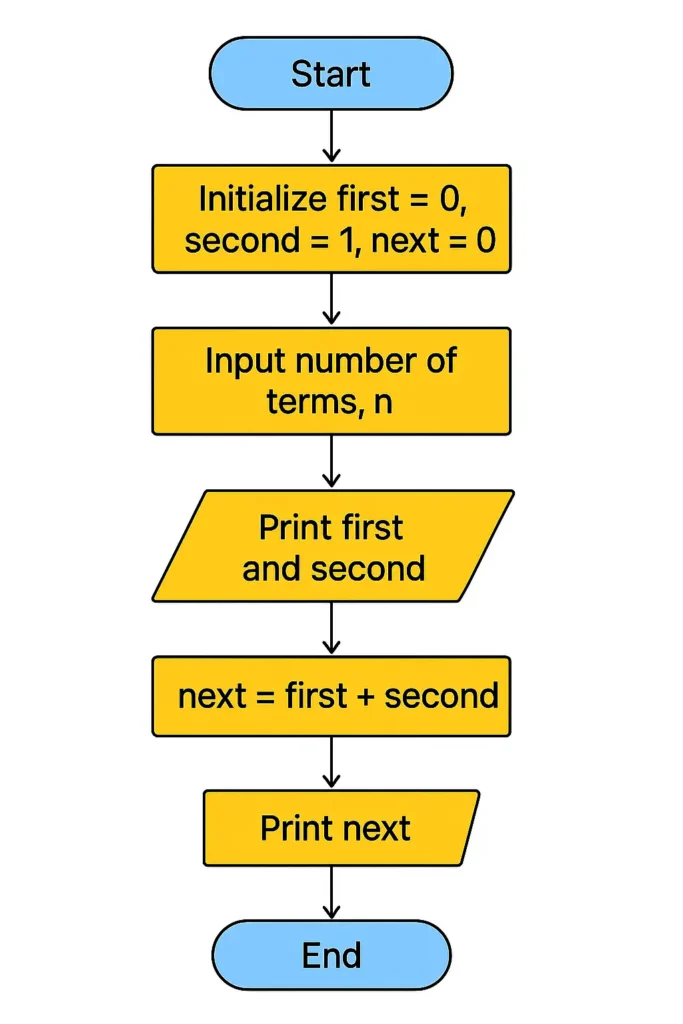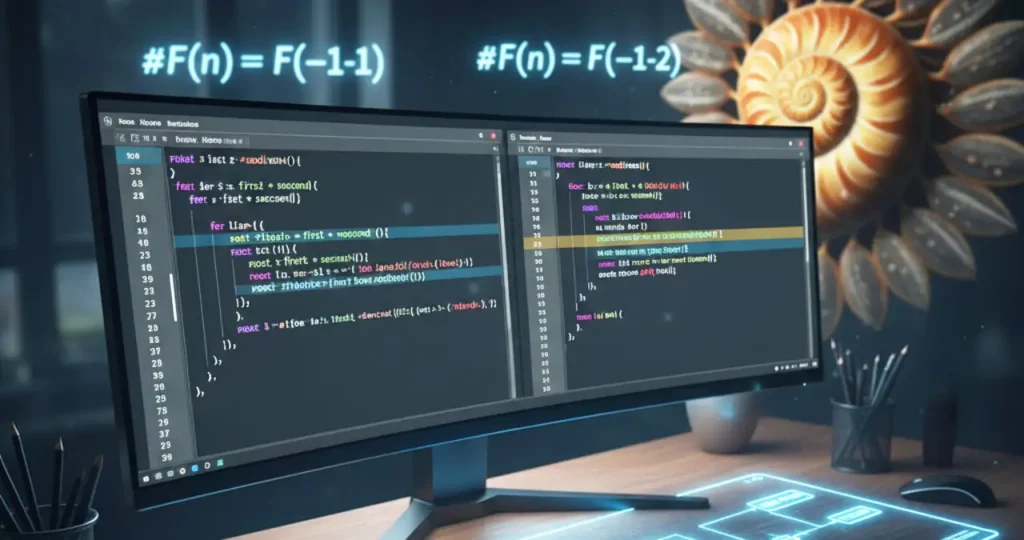The Fibonacci series is one of the most fascinating logics for beginners to practice in C. It’s a masterpiece in programming.
Individuals follow different algorithms and logics to write C programming code to find this series of numbers. But I have the easiest-to-follow flowchart and algorithm to write a Fibonacci series program in C.
First, we will understand what the Fibonacci series is, interesting algorithms, flowcharts, easy codes, and a few common mistakes beginners often make. Don’t worry, I have also shared debugging tips at the end.
So, here goes your perfect starting point!
What Is the Fibonacci Series?
The Fibonacci series is a special sequence of numbers where each number is the sum of the two numbers before it. The series starts with 0 and 1, and it continues like 0, 1, 1, 2, 3, 5, 8, 13, 21, 34, 55, …
Here’s a short rule to calculate the Fibonacci series in math:
F(n) = F(n-1) + F(n-2)
This means that each number value depends on the two terms before it. This series also appears in many real-life happenings, like the arrangement of leaves on a stem, the spiral of a seashell, and in different computer algorithms.
Algorithm for Fibonacci Series & Logic in C
The Fibonacci Series Program in C follows a simple rule. Each new number is the sum of the two previous numbers in the sequence. But in the C language, you can generate this special number of series by using two primary approaches:
- Iterative Method (using loops): Great start for beginners
- Recursive Method (using function calls): Shows how a problem can be easily solved by breaking it into smaller subproblems.
Algorithm for the Iterative Method
Step 1: Start
Step 2: Initialize three variables:
first = 0, second = 1, and next = 0
Step 3: Input the number of terms n you want to print
Step 4: Print the first two terms (first and second)
Step 5: Repeat the following steps from the 3rd term to the n-th term:
→ next = first + second
→ Print next
→ Update values:
first = second
second = next
Step 6: End
Flowchart

Algorithm for the Recursive Method
Step 1: Start
Step 2: Define a recursive function fibonacci(n) that:
→ Returns 0 if n == 0
→ Returns 1 if n == 1
→ Otherwise returns fibonacci(n-1) + fibonacci(n-2)
Step 3: Input the number of terms n
Step 4: Call the function for each term and print the result
Step 5: End
Flowchart

Easy Fibonacci Series Program in C
Program Using Loop
| #include <stdio.h> int main() { int n, first = 0, second = 1, next; // Ask the user for the number of terms printf(“Enter the number of terms: “); scanf(“%d”, &n); // Print the first two Fibonacci numbers printf(“Fibonacci Series: %d, %d”, first, second); // Loop to generate the next numbers for (int i = 3; i <= n; i++) { next = first + second; // Calculate next term printf(“, %d”, next); // Print the term first = second; // Update values second = next; } return 0;} |
Explanation
Step 1: Start the program
- Include the stdio.h header file for input/output functions.
Step 2: Declare variables
- Declare int n, first = 0, second = 1, next;
- These variables will store the number of terms and Fibonacci values.
Step 3: Take user input
- Use scanf(“%d”, &n); to read how many terms the user wants.
Step 4: Print the first two terms
- Display 0 and 1 as the first two numbers of the series.
Step 5: Use a loop to calculate the next terms
- Run a for loop from i = 3 to i <= n.
- In each iteration:
- Calculate next = first + second.
- Print the next value.
- Update the values:
- first = second;
- second = next;
Step 6: End the program
- When the loop finishes, all Fibonacci numbers up to n are printed.
Program Using Recursion
| #include <stdio.h> // Recursive function to return Fibonacci valueint fibonacci(int n) { if (n == 0) return 0; // Base case 1 else if (n == 1) return 1; // Base case 2 else return fibonacci(n – 1) + fibonacci(n – 2); // Recursive step} int main() { int n; printf(“Enter the number of terms: “); scanf(“%d”, &n); printf(“Fibonacci Series: “); for (int i = 0; i < n; i++) { if (i == n – 1) printf(“%d”, fibonacci(i)); // No comma after last number else printf(“%d, “, fibonacci(i)); // Print comma after each number } return 0;} |
Explanation
Step 1: Start the program
- Include the stdio.h header file.
Step 2: Define a recursive function
- Write a function int fibonacci(int n) that returns the nth Fibonacci number.
- Inside the function:
- If n == 0, return 0 (base case 1).
- If n == 1, return 1 (base case 2).
- Otherwise, return fibonacci(n – 1) + fibonacci(n – 2) (recursive call).
Step 3: Take user input
- In the main() function, ask the user to enter the number of terms.
Step 4: Print the Fibonacci series
- Use a for loop from i = 0 to i < n.
- For each iteration, call the function fibonacci(i) to get the next Fibonacci number.
- Print each value with a comma (except after the last number).
Step 5: End the program
- Once the loop completes, the program stops after printing all terms.
Common Mistakes and Debugging Tips
1. Incorrect Base Cases in Recursion
- Forgetting to define fibonacci(0) and fibonacci(1) correctly.
- Example mistake: if(n==0) return 1; → This gives wrong Fibonacci values.
2. Using int for Large Fibonacci Numbers
- Fibonacci numbers grow fast; int may overflow for n > 46.
- Example mistake: int fib = fibonacci(50); → wrong result due to overflow.
3. Forgetting to Initialize Variables in the Loop Method
- Variables like a, b, next must be initialized before the loop.
- Example mistake: int a, b, next; → printing next without initializing a and b.
4. Wrong Loop Conditions
- Using incorrect conditions in for or while loops.
- Example mistake: for(i=0;i<=n;i++) when only n numbers are needed → prints one extra number.
5. Not Handling Negative Input
- Fibonacci is undefined for negative numbers; input validation is often skipped.
Debugging Tips
➜ To trace the recursion step by step, write the function calls on paper to check if the recursion returns correct values.
➜ For iterative methods, print a, b, and next at each step to ensure correctness.
➜ Avoid integer overflow for bigger Fibonacci numbers:
long Fibonacci(INT n);
➜ Comment each step to avoid confusion in loops or recursion.
➜ Ensure the input n is ≥ 0.
Conclusion
Mastering the Fibonacci series program in C not only strengthens your understanding of basic programming but also lays a solid foundation to tackle more complex situations. You can experiment with the two different methods I have mentioned above to gain deeper insight into problem-solving.
Remember that each error or bug offers a learning opportunity. So, practice this powerful programming exercise and leave a comment if you face any issues.


